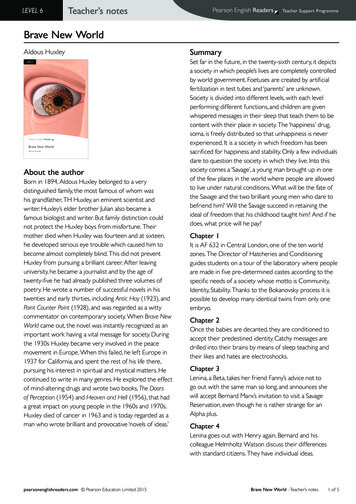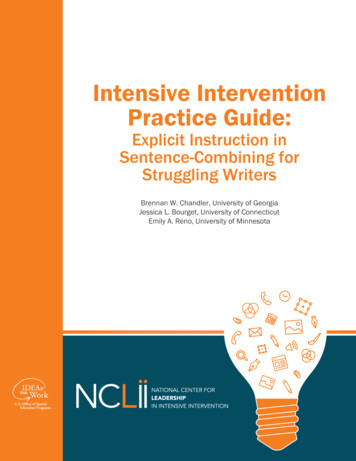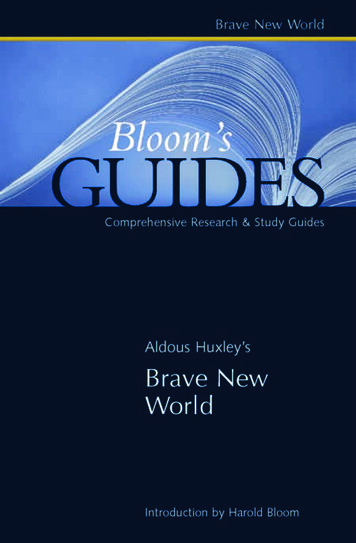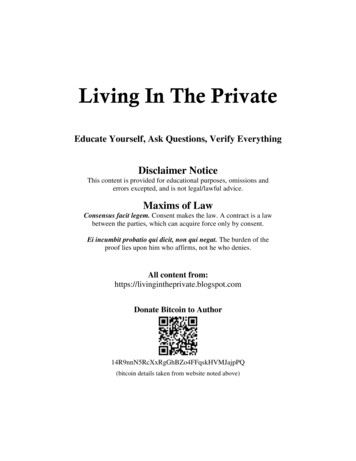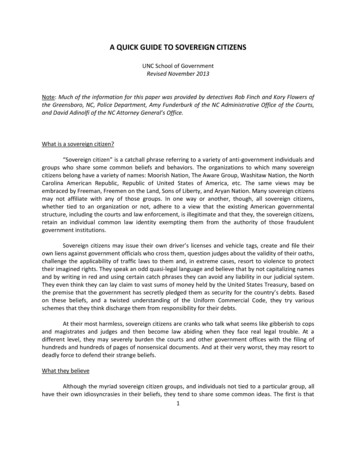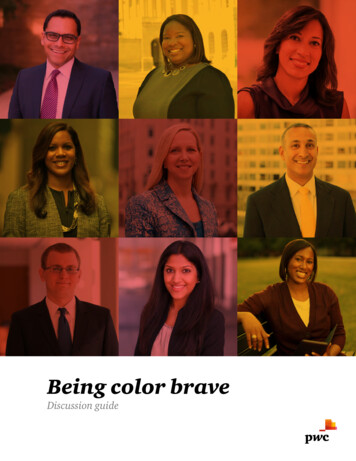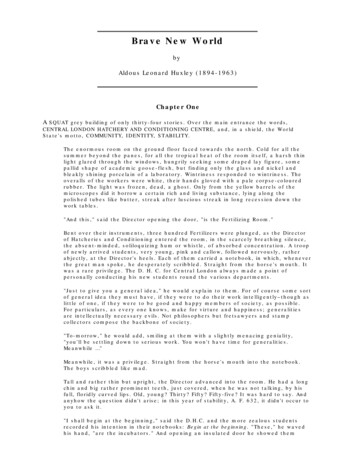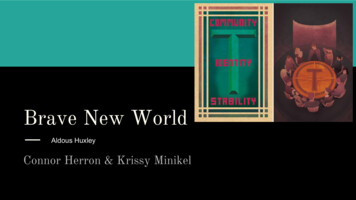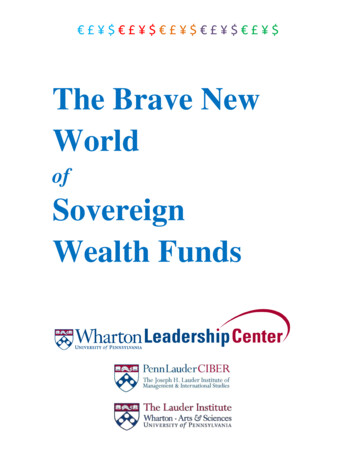
Transcription
The Brave NewWorldofSovereignWealth Funds
2010 The Trustees of the University of Pennsylvania. All rights reserved. You maynot copy, reproduce, create derivative works from, publicly distribute, or publicly displayor transmit any of these materials, including but not limited to storage in a retrievalsystem, or transmission electronically, mechanically, via photocopying, recording, orother means, without prior written permission from the Lauder Institute of Management& International Studies, University of Pennsylvania, except as permitted by law. Torequest permission, please contact guillen@wharton.upenn.edu.
Table of Contents1. The Rise of Sovereign Wealth Funds2. History and Concept of Sovereign Wealth Funds3. Sovereign Wealth Funds in Latin America4. Sovereign Wealth Funds in the Middle East5. Legal and Regulatory Aspects of Sovereign Wealth FundsAppendix: Essential Readings on Sovereign Wealth FundsCredits
1The Rise of Sovereign Wealth FundsRecent years have witnessed the rise to prominence of a new category ofinternational investors known as sovereign wealth funds (SWFs). The largest include: Japan‘s Government Pension Investment Fund,Abu Dhabi Investment Authority,Holland‘s Stichting Pensioenfonds,Norway‘s Government Pension Fund-Global,California Public Employees‘ Retirement System,Government of Singapore Investment Corporation,Saudi Arabian Monetary Agency,Kuwait Investment Authority, andChina Investment CorporationCollectively, SWFs managed assets in excess of US 5 trillion as of the end of 2007,although many suffered losses of 30%-40% during 2008.1 While the phenomenon datesback to the 1950s, the term dates back only to 2005. 2 SWFs have become importantplayers in worldwide portfolio investing, especially in the wake of the economic andfinancial crisis of 2007-2008, when they took stakes in companies as prominent as UBS,Citigroup, Morgan Stanley, Merrill Lynch, Barclays, Blackstone, Standard Chartered,and the Carlyle Group.According to the U.S. Department of the Treasury, SWFs are assets that agovernment (or government-linked entity) holds in another country‘s currency, with thegoal of attaining a long-term return, but that it manages separately from its foreigncurrency reserves, which it uses for stabilization and short-term liquidity purposes.31Brad Setser and Rachel Ziembra, ―GCC Sovereign Funds: Reversal of Fortune,‖ Council on ForeignRelations, Working Paper, hments/CGS WorkingPaper 5.pdf.2Andrew Rozanov, ―Who Holds the Wealth of Nations?‖ Central Banking Journal, 2005. Reprinting byState Street pdf.3U.S. Department of the Treasury, Office of International Affairs, ―Appendix III: Sovereign Wealth Funds,‖in Semiannual Report on International Economic and Exchange Rate Policies, irs/economic-exchange-rates/pdf/2007 Appendix-3.pdf. Par. 2.For a more lengthy and detailed treatment of both topics, see Simone Mezzacapo, ―The So-called1
The International Monetary Fund (IMF) states that ―SWFs can generally be definedas special investment funds created or owned by governments to hold foreign assets forlong-term purposes,‖ 4 while the Organization for Economic Cooperation andDevelopment (OECD) argues that ―SWFs are essentially government-owned investmentvehicles funded by foreign exchange assets.‖5Given the difficulties associated with providing a working definition, some suggestthat ―a practical way to identify SWFs could be to define them by exclusion—a usefulreference is the fairly comprehensive and inclusive definition proposed by ‗State Street‘,according to which SWFs are essentially sovereign-owned asset pools which are neithertraditional public pension funds nor traditional reserves assets supporting nationalcurrencies.‖6 For its part, the International Working Group of Sovereign Wealth Fundsdefines them asspecial purpose investment funds or arrangements, owned by the generalgovernment. Created by the general government for macroeconomic purposes,SWFs hold, manage, or administer assets to achieve financial objectives, andemploy a set of investment strategies which include investing in foreign financialassets. The SWFs are commonly established out of balance of paymentssurpluses, official foreign currency operations, the proceeds of privatizations,fiscal surpluses, and/or receipts resulting from commodity exports.7Finally, the Sovereign Wealth Fund Institute, an organization that studies sovereignwealth funds and their global impact, provides the following definition:A Sovereign Wealth Fund (SWF) is a state-owned investment fund composed offinancial assets such as stocks, bonds, real estate, or other financial instrumentsfunded by foreign exchange assets. These assets can include: balance ofpayments surpluses, official foreign currency operations, the proceeds ofprivatizations, fiscal surpluses, and/or receipts resulting from commodity exports.Sovereign Wealth Funds can be structured as a fund, pool, or corporation. Thedefinition of sovereign wealth fund exclude [sic], among other things, foreigncurrency reserve assets held by monetary authorities for the traditional balance ofpayments or monetary policy purposes, state-owned enterprises (SOEs) in thetraditional sense, government-employee pension funds, or assets managed for thebenefit of individuals.8‗Sovereign Wealth Funds‘: Regulatory Issues, Financial Stability and Prudential Supervision,‖ EuropeanEconomy, Economic Papers 378, April 2009, Directorate-General for Economic and Financial Affairs,European Commission, http://ec.europa.eu/economy finance/publications/publication15064 en.pdf.4International Monetary Fund, Global Financial Stability Report, October /02/pdf/text.pdf.5Ibid.6State Street, Sovereign Wealth Funds, Assessing the Impact, Vision, Vol. III, Issue 2, pp. 3-6 (emphasis inthe original).7International Working Group of Sovereign Wealth Funds, ―Sovereign Wealth Funds: Generally AcceptedPrinciples and Practices (‗Santiago Principles‘), inciples.pdf. 27.8Sovereign Wealth Fund Institute, ―What Is a Sovereign Wealth Fund?‖ November 16, 2009,http://www.swfinstitute.org/swf.php.2
We will define SWFs here as funds owned or controlled by sovereign governments,composed of foreign assets, held for a purpose other than that of supporting the currency,that the government may use to support state pensions,to manage large surpluses such as profits from oil production,to earn a return on capital,for the public interest,to manage foreign exchange asset reserves, orto achieve other objectives.How Many Sovereign Wealth Funds Are There and How Big Are They?Two key reasons make this question subtly difficult to answer: (1) the numberdepends on the definition one uses for SWFs, and (2) many funds are secretive abouttheir holdings, making it difficult to be certain of their sizes.According to Edward Truman, creator of the ―Truman Scoreboard‖ for evaluating andcomparing SWFs, there are at least 32, which range in size from under US 1 billion topossibly US 900 billion. 9 Another revealing list is that of the members of theInternational Forum of Sovereign Wealth Funds, a forum in which the SWFs of variouscountries ―will meet, exchange views on issues of common interest, and facilitate anunderstanding of the Santiago Principles and SWF activities.‖10 Among the 23 membernations of the forum, there are 25 member SWFs. 11 Interestingly, the ―MembersInformation‖ page on the website has varying levels of detail about each fund, rangingfrom explicit declarations of funds‘ sizes and goals (Norway, among others) to no entryat all (Equatorial Guinea, Iran). Perhaps the most thorough list thus far is that of theSovereign Wealth Fund Institute, with 56 known or presumed funds12 (see Exhibit 1.1).The size of a fund depends primarily on its purpose and the size and wealth of thestate funding it. For example, among the largest funds are those of the United ArabEmirates and Norway, most of which manage excess revenues earned from petroleum.Not all oil funds are that large, though. Sudan, São Tomé-Príncipe, and Azerbaijan allhave oil-revenue-based funds that manage less than US 2 billion each.139Edward M. Truman, ―A Scoreboard for Sovereign Wealth Funds,‖ Peterson Institute for InternationalEconomics, Paper presented at conference on China‘s Exchange Rate Policy, Peterson Institute,Washington, D.C., 2007, wf.pdf, p. 10.10International Forum of Sovereign Wealth Funds, ―International Forum of Sovereign Wealth Funds,‖November 16, 2009, http://www.ifswf.org/index.htm.11Ibid.12Sovereign Wealth Fund Institute, op. cit.13Truman, op. cit., p. 10.3
However, there are two primary reasons for the rapid appearance and growth ofSWFs: the rapidly increase in oil prices and the accumulation of large balance-ofpayments surpluses.14First, many funds came about as an outlet for managing the extreme wealth that camewith the rapid rising price of petroleum. Some of these, such as Norway‘s, double aspension funds. Others, such as many of the funds that belong to members of the GulfCooperation Council, are more clearly intended to manage government wealth whileearning a return.These funds can play a valuable role in stabilizing the economy during business-cycletroughs, particularly in these oil-rich countries that can have turbulent economic cycles.According to a report from Booz and Company, a consultancy, ―Saudi Arabia‘s centralbank, which had accumulated significant excess foreign reserves since the 1970s, wasable to cushion the severity of a decade of slow growth by infusing money into the Saudieconomy. Similarly, the Kuwait Investment Authority was instrumental in rebuilding theKuwaiti economy in the aftermath of the invasion of Kuwait and the 1990 Gulf War.‖15The combination of increased stability, increased returns, and greater economicpower through the concentration of its finances makes the creation of an SWF anappealing policy for such powers. The funds with this background are among both thewealthiest and least transparent in the world, making them powerful as well as elusive.Second, a number of countries developed their funds on the basis of enormous tradesurpluses. China provides a classic example. For many years, China‘s rapid exportgrowth but relatively limited import growth has caused it to accumulate an ever-growingsum of dollars in its foreign exchange reserve; this reserve reached US 1.2 trillion byMarch 2007. 16 As a consequence of the rapid increase within the last decade, thegovernment has given much of this to the China Investment Corporation to manage.Following the onset of the worldwide financial crisis in late 2008, the landscape forSWFs has become even more important. Governments or funds bailed out manypolitically salient and connected companies and institutions, which either became entitiessimilar to SWFs or became controlled wholly or in part by foreign SWFs.The American banks and insurance agencies affected most during the beginning ofthe financial crisis are the best examples of this, as the U.S. government now owns AIG.The Kuwait Investment Authority, Temasek, and the Abu Dhabi Investment Authority allhold significant portions of the stock of Citigroup, Merrill Lynch, Barclays, and UBS (seeExhibit 1.2).14Mezzacapo, op. cit., p. 18.Richard Shediac and Hatem Samman, ―The Vital Role of Sovereign Wealth Funds in the GCC‘s Future,‖Booz and Company, 2009, http://www.booz.com/media/uploads/Vital Role Sovereign Wealth Funds.pdf,p. 2.16Luan Shanglin, ―China‘s Forex Reserve Tops 1.2 trillion USD,‖ China View, April 13, 2007, March 1,2010, nt 5969028.htm.154
While many other investors have been particularly cautious, SWFs have been active,seeing this as an opportune time to invest in valuable companies at low prices, for bothbetter returns and more control. It remains to be seen what the future effect of this willbe. To be sure, SWFs have not escaped the crisis unscathed. Estimates suggest thatduring 2008 the Abu Dhabi Investment Authority lost 40% of its fund value, the KuwaitInvestment Authority lost 36%, the Qatar Investment Authority lost 41%, the SaudiArabian Monetary Agency lost 12%, and the Norwegian Government Pension FundGlobal lost 30%.1717Setser and Ziembra, op. cit.5
Exhibit 1.1The Main Sovereign Wealth FundsYearFounded1976Main Source ofFundsCommodityCurrent Size(US bn)8751976197620041983CommodityCommodityFiscal surplusesaCommodity29164430Canadaa1966a121aChina InvestmentCorporationEconomic and SocialStabilization FundaGovernment ofSingapore saForex reservesaChilea2006aNatural resourcesa15aSingapore1981330Government PensionFund of NorwayInvestment Corporationof DubaiKazakhstan NationalFundKhazanah NationalKorea InvestmentCorporationKuwait InvestmentAuthorityLibyan InvestmentAuthorityaOil IncomeStabilization FundaNational PensionsReserve FundQatar InvestmentAuthorityRevenue RegulationFundSaudi ArabianMonetary AgencyaStabilization Fund (andNational Welfare Fund)Temasek HoldingsNorway1990Forex reserves,fiscal surpluses,employeecontributionsaCommodityUnited 38MalaysiaRepublic ofKoreaKuwait19932005Fiscal surplusesaForex reservesa26301953Commodity265Libyaa2006aNatural resourcesa50aMexicoa2000aNatural odity60Algeria2000Commodity47Saudi Arabiaa1952aNatural OEsa134NameAbu Dhabi InvestmentAuthorityAlaska Permanent FundAlberta‘s Heritage FundAustralia Future FundBrunei InvestmentAgencyCanada Pension PlanaCountryUnited ArabEmiratesUnited StatesCanadaAustraliaBrunei6200301
Exhibit 1.1 (cont.)Note:aEdward M. Truman, ―A Blueprint for Sovereign Wealth Fund Best Practices,‖ Peterson Institute for InternationalPolitics, Policy Brief, 2008, b08-3.pdf.Source: Simone Mezzacapo, ―The So-called ‗Sovereign Wealth Funds‘: Regulatory Issues, Financial Stability andPrudential Supervision,‖ European Economy, Economic Papers 378 (Brussels: European Commission,Directorate-General for Economic and Financial Affairs, April 2009) (unless otherwise noted).http://ec.europa.eu/economy finance/publications/publication15064 en.pdf.Exhibit 1.2Sovereign Wealth Funds That Made Major Acquisitions During the Crisis (January2007-December 2009)StakeSWFGIC of SingaporeAbu Dhabi Investment AuthorityGIC of SingaporeChina Investment CorporationTemasek (Singapore)Qatar Investment AuthorityKuwait Investment OfficeKuwait Investment OfficeChina Investment CorporationKorea Investment CorporationTemasek (Singapore)Temasek (Singapore)Saudi Arabian Monetary AgencyAbu Dhabi Investment AuthorityTarget CompanyUBSCitigroupCitigroupaMorgan StanleyMerrill LynchbBarclayscMerrill LynchCitigroupdBlackstoneMerrill LynchBarclaysStandard CharteredUBSCarlyle GroupNotes:aSold in September 2009 at a reported US 1.6 billion profit.bSold at the end of March 2009.cReduced to a 5 % stake in April 2009.dSold in December 2009 at a reported US 1.1 billion profit.Sources: European Central Bank; Sovereign Wealth Fund Institute.7US 94.49.911.37.77.01.610.04.31.85.42.07.5
2History and Concept of SovereignWealth FundsOver the past several years, sovereign wealth funds have grown to occupy a significantposition in both the financial markets (the funds are believed hold up to 3 trillion ofassets) 18 and in the popular consciousness. The background of these funds isconsequently best examined as two separate histories: i) the history of the concept andpopular perception of sovereign wealth funds and ii) the history of the actual pools ofcapital that are classified as sovereign wealth funds.Concept of Sovereign Wealth FundsAlthough the concept of a pool of capital controlled by a government and invested inassets seeking returns above the risk-free rate19 is not unique enough to claim a specificpoint of invention, the phrase ‗sovereign wealth fund‘ is popularly believed to have beencoined in 2005 by Andrew Rozanov of the Official Institutions Group at State StreetAdvisors. Although it may be surprising that a term so firmly entrenched in theAmerican lexicon is less than 5 years old, popular usage of the term (and popular focuson the funds on themselves) really only began in the second quarter of 2007. A mediasearch of articles containing the phrase ‗sovereign wealth fund shows little to no usage ofthe phrase prior to 2Q2007, and a huge spike in usage at the end of 2007 and start of 2008.18A Portfolio Analysis Of Sovereign Wealth Funds, Christopher Balding, University of California Irvine,June 6, 2008 Pg. 319A Portfolio Analysis Of Sovereign Wealth Funds, Christopher Balding, University of California Irvine,June 6, 2008 Pg. 108
Exhibit 2.1: Frequency of search „sovereign wealth fund‟ occurring in Google articlesearchSovereign wealth fund managers themselves were caught off guard by the largelynegative attention suddenly focused on their funds. Bader Al Sa‘ad Managing Directorof the Kuwait Investment Authority recalled:When the whole issue of the size of Sovereign Wealth Funds emerged in 2007 The media was in a frenzy regarding the threat from Sovereign Wealth Funds, withprojections of the size of assets under management based on unrealisticexpectations.20Examination of written media usage of ―sovereign wealth fund‖ combined with phraseslike ‗threat‘ or ‗danger‘ shows a similar increase in usage (10% of articles makingreference to sovereign wealth funds contained the word ―threat‖ in January 2008).Exhibit 2.2: Frequency of search „ “sovereign wealth fund” threat‟ occurring inGoogle article searchPopular media, and governmental concerns largely centered on about sovereign wealthfunds‘ lack of transparency, potential for technology transfer, and the potential forgovernments to influence management decisions that benefit a nation rather thanoptimize shareholder value.The logic of the capitalist system depends on shareholders causing companies to act soas to maximize the value of their shares. It is far from obvious that this will over timebe the only motivation of governments as shareholders. They may want to see theirnational companies compete effectively, or to extract technology or to achieveinfluence.21However, as the financial crisis heated up, the liquidity that sovereign wealth funds wereable to provide caused the funds to be viewed in a much more positive light, causing a20Bader Al Sa‘ad Managing Director of Kuwait Investment Authority, On the Occasion of the Visit of theWorking Group of Sovereign Wealth Funds, April 5, 200921Larry Summers, quoted in The Evening Standard (London), Pg. 27, September 21, 20079
percentage increase in positive media reports on sovereign wealth funds at the end of2008.Exhibit 2.3: Frequency of search „ “sovereign wealth fund” savior‟ (top) and„ “sovereign wealth fund” save‟ bottom occurring in Google article searchHistory of Various Sovereign Wealth FundsDespite the new attention paid to sovereign wealth funds and the recent increase in boththe number and size of sovereign wealth funds, the largest funds are not new institutions.The Kuwait Investment Authority claims to be the oldest22 sovereign wealth fund, but theoldest significantly sized fund meeting the IMF, Edwin Truman Institute for InternationalEconomics, and Balding definitions for a sovereign wealth fund is the California PublicEmployees Retirement System23 (―CalPERS). Although CalPERS is different from thepopular conception of sovereign wealth funds in the regard that CalPERS serves a staterather than a nation, the fund‘s history is useful to examine in order to forecast the futurebehavior of newer more ‗prototypical‘ sovereign wealth funds.CalPERS was started in 1932 during the great depression after eleven years of politicalagitation and a necessary state constitution change. CalPERS was initially a bond-onlyfund, but legislative modifications allowed for the addition of real estate in 1953 andstocks in 1967. Interestingly, the impetus for CalPERS to begin making foreign equityinvestments mirrors the impetus driving the foundation of oil based sovereign wealthinvestment funds: the desire to preserve wealth even if domestic economies lose theircompetitive advantage (oil in the for some funds, or manufacturing for CalPERS) and aresupplanted by foreign economies. CalPERS pushed through a proposition allowing for22The Independent (London), February 26, 2008 Tuesday, EU to agree code of principles for sovereignwealth funds23A Portfolio Analysis Of Sovereign Wealth Funds, Christopher Balding, University of California Irvine,June 6, 200810
foreign investment in 1984 after being influenced by U.S. Ambassador to Japan MikeMansfield‘s assertion that ―[i]f American consumers are going to continue buyingJapanese products, then its best for U.S. investors to also invest in these companies.‖CalPERS in now approximately 20% foreign equities and 26% global fixed income.24Instructively, during its relatively long history, CalPERS has confronted two issues thatrecur as themes for sovereign wealth funds - the need to take an active shareholder role,and the threat of political interference: CalPERS has fought off efforts by stateGovernors to tap or privatize the fund, and was a pioneer in unifying public pensionfunds into the Council of Institutional Investors in order to pressure their portfoliocompanies into focusing on creating greater shareholder value.25The first sovereign wealth fund, the Kuwait Investment Authority established The KuwaitInvestment Office (the fund‘s London investment office) in 1953 in order to invest oilrevenues and reduce Kuwait‘s reliance on Oil. 10 percent of all state revenues aretransferred annually to the Future Generations Fund, including 10 percent of the incomegenerated by the General Reserve Fund. 26 By 1986, government revenue frominvestments exceeded oil revenue.27Kuwait it‘s probably the oldest sovereign funds in the world the objectivewas to transfer non-recurring assets, highly volatile which was the oil, into adiversified portfolio. To create a social stability in the country. I think [thefund] has worked well during the Iraqi invasion [in] 1990 when Kuwait hasbeen occupied by Iraq for three years Kuwait does not have a source ofincome, no revenue at all. 80-85bn was spent from the funds to finance thebudget. This is the reason why these funds has been created.28The Kuwait Investment Authority emphasizes the passive nature of their investmentstrategy, saying, ―we have been passive in all our investments. We haven‘t played anactive role or been an activist with [any] of our shares.‖ 29 Although KIA made in 1983outright acquisition of Autobar, the largest European hot and cold beverage and foodvendor, it subsequently disposed of this investment as it contradicted KIA‘s statedpassive investor policy.30 Taking a more active role in investments is not uncommon forlarge sovereign wealth funds, and may perhaps become a necessity when shareholdingsgrow as large as CalPERS‘s or Kuwait‘s.Kuwait‘s 1953‘s sovereign wealth fund start, was joined shortly thereafter by anothercommodity fund: the Kiribati Revenue Equalisation Reserve Fund was founded in 1956.Like Kuwait‘s sovereign wealth fund, the Kiribati Revenue Equalisation Reserve Fundwas established to capture proceeds from the export of a finite resource (guano forfertilizer) and create wealth for future generations. Because most countries which have24Pension & Investments, May 14, 2007, Raquel PichardoCouncil of Institutional Investors website, http://www.cii.org/about/history26Kuwait Investment Authority Website, spx27Kuwait Investment Authority Website, spx28Bader Al Sa‘ad Managing Director of Kuwait Investment Authority, at Davos 200829Bader Al Sa‘ad Managing Director of Kuwait Investment Authority, at Davos 200830Kuwait Investment Authority Website, spx2511
set up sovereign wealth funds in order to preserve finite natural resource wealth are stillin the in accumulation phase of their fund lives, the performance of the Kiribati RevenueEqualisation Reserve Fund is an important bellwether – the 400m fund should boost theisland nation's GDP by a sixth this year.31The 1970s brought the foundation of several new sovereign wealth funds, including theoil-funded Abu Dhabi Investment Authority (which is now thought to be the largestsovereign wealth fund) and the less prototypical Temasek. Temasek was founded in1974 with an initial portfolio of approximately 100mm, and was founded as a―sovereign poverty fund,‖32 meaning that rather than serving as a means of preservingwealth across generations, the fund was intended to assist in managing the growth of theSingaporean economy. Temasek vigorously asserts that they are not a sovereign wealthfund owing to the fact that fund does not receive additional funding from the government(it funds new investments by selling old investments) and does not require governmentapproval in its decision making process. Temasek also shies away from the term ―activist‖but acknowledges that they are an ―active‖ investor and was in fact formed i) take overthe investment holdings of an ―embattled government‖ and ii) ―provide an independentlyfocused, professionally managed and commercially disciplined approach toinvestments.‖33The late 1970s brought emergence of other oil-based Sovereign Wealth funds (the AbuDhabi Investment Authority, Alaska‘s Permanent Fund, Alberta's Heritage Fund, andOman‘s State General Reserve Fund) and signaled a correlation that would be repeatedlater: petrol based sovereign wealth funds are founded during periods of high oil prices31The Economist, January 19, 2008,The Business Times Singapore, acceptance speech of Ho Ching at Asia Society's June 25, 2008 dinner33The Business Times Singapore, acceptance speech of Ho Ching at Asia Society's June 25, 2008 dinner3212
Exhibit 2.4: Founding Years for Oil Based Sovereign Wealth Funds and Oil PricesRising Demand; Low Spare Capacity ; WeakDollear; Geopolitical Concerns120Oil Based Sovereign Wealth Fund FoundingNominal Dollars per Barrel100Nigerian Cut-OffsEvents Oil PricesHurricanes Dennis, Katrinaand Rita in Gulf of Mexico80PdVSA Worker's Strikein Venezuela and Iraq War Worries60Iran-Iraq WarOman4020RussiaSuadi ArabiaMalaysiaLibyaDubaiBahrainMauritaniaOmanAbu DhabiAlaskaAlbertaAlgeriaKhazakhstan Ral KhaymahTrinidad and TabagoIraq Invades KuwaitOman Abu yBuildVenezualaArab OilEmbargo9/11 AttacksSaudi Arabia Abandons SwingProducer RoleNorwayOPEC Cuts Quotas;Rising DemandAsian Economic Crisis01970 1972 1974 1976 1978 1980 1982 1984 1986 1988 1990 1992 1994 1996 1998 2000 2002 2004 2006 2008Source: EIA& internetOfficial Price of Saudi LightRefiner Acquisition Cost of Imported Crude Oil (IRAC)As mentioned in the history of the concept of the sovereign wealth fund, there wasanxiety directed towards sovereign wealth funds starting in the second half of the 2000s.This is anxiety was potentially caused both by the rapid increase in the number of fundsover the previous decade, by the size of assets under management, and by the perceivedcharacter of the countries which where establishing funds: Iran, Nigeria, Saudi Arabia,China, Venezuela, Qatar, Libya, and Oman all established funds after 1998. The depth ofthese countries image problems can be seen with Iran, Nigeria, and Saudi Arabiacapturing the last three places on the Anholt-GfK Roper Nations Brands Index (AnholtGfK Roper Nations Brands Index is a measure of the global perception of a country).Over the past several years, the frequency of sovereign wealth fund openings hasaccelerated. 20 funds were opened by 2000, 20 new funds have opened since 2000 - 10of which were opened after 2005.34 Despite the initial concerns, no fund has yet to beseriously criticized for having a more negative impact than traditional investmentvehicles but rather the funds have gained credit for their positive role in ameliorating thefinancial crisis.35There is a lot of worry about the sovereign funds, but all of these worries areassumptions or expectations; there is no real case [of sovereign wealth funds34U.S. Treasury Department, Deputy Assistant Secretary for Asia Robert Dohner, Statement before the U.S.- China Economic and Security Review Commission, February 7, 2008 pg. 135South China Morning Post, Nick Westra quoting David Cohen, an economist at Action Economics,February 12, 2008 Pg. 213
making decisions on a non-commercial basis]; KIA has been a shareholder inDaimler Benz since 1969, a shareholder in British Petroleum since 1986; interms of governance, we always made decisions on a commercial basis, alwaysbeen passive and never been activist there is no real basis for concern.3636Bader Al Sa‘ad Managing Director of Kuwait Investment Authority, at Davos 200814
3Sovereign Wealth Funds in LatinAmericaWhile Latin America is a region endowed with vast natural resources, historically ithas not historically deve
The Brave New World of Sovereign . Recent years have witnessed the rise to prominence of a new category of international investors known as sovereign wealth funds (SWFs). The largest include: . wealthiest and least transparent in the

